
The Tale of Two 'Ps' - Plants and Pollinators
Cathy Powers
I recently read an article titled 'Sex and Death' which described an exhibition at the Sydney Tropical Centre. This exhibition, to depict the evolutionary process of plants along with their insect pollinators, is a display of orchids and carnivorous plants.
The title itself piqued my interest and one statement, within the article, leads me to write about the first part - 'sex'. Now don't get too excited because this will be a few facts and a bit of speculation but only with regards to orchids. The statement read "The relationship between orchids and their pollinators is interpreted in three themes: 'Seduction', 'Cooperation' and 'Deception'.
Before I offer some explanation to these three concepts, it is imperative to describe two orchid components which will assist the understanding of each mechanism.
Column
Unique to orchids is the reproductive component made up of one large stamen and one large style which are fused together to form a club headed rod known as the column. This is the reproductive organ of the orchid.
A good example of this is demonstrated in the Eriochilus cucullatus (Parson's Bands) - Photo 1.
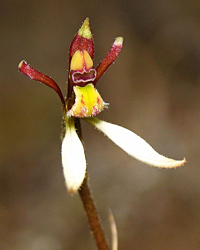 |
|
 |
|
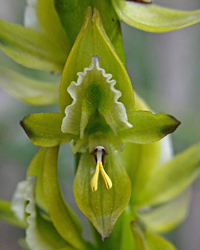 |
1. Column example
Eriochilus cucullatus |
|
2. Labellum example
Lyperanthus suaveolens |
|
3. Pollen packets of Leek
Orchid
Prasophyllum elatum |
| Photos: Cathy Powers |
Labellum
The labellum, once a petal, evolved to serve as a landing platform for pollination. The Thelymitra species, with a couple of exceptions, is the only terrestrial orchid which has not developed a unique labellum.
The Lyperanthus suaveolens (Brown Beaks) displays a wondrous construction with the rounded yellow calli covering most of the labellum - Photo 2.
Cooperation - Example
Leek Orchids (Prasophyllum), unlike most other orchids, actually do offer their pollinating insect sustenance.
The Prasophyllum flower is inverted and the shiny area mid labellum has nectar containing cells which are enticing to various insects including hover flies, crane flies, beetles, bees and wasps (all of which are potential pollinators).
Because of this, most Leek Orchids have a sweet smell and on warm days this can be quite pungent. The Leek Orchid pollen packet is neatly situated within the column structure and appears to be attached to a spring-loaded strap. When disturbed, the strap flips the uniquely configured packet forward - Photo 3. It is this action that obviously places the pollen packet in a position to be attacked (broken apart) by the various visiting insects while searching for nectar - Photo 4.
Deception - Example
A form of orchid deception is the mimicking of nearby nectar producing flowers.
Diuris are some of the best at doing this but they don't play fair since their flower is usually bigger, extra colourful and more conspicuous than the flower they are trying to emulate. Their large flowers may look like those of nectar-offering plants that grow nearby but the orchid offers nothing to the unsuspecting insect.
Having learned that flowers of a particular shape are worth visiting, the pollinator is willing to approach other likely food sources. Many Diuris look very similar to a member of the Fabaceae plant group (pea flowers) which happen to flower at similar times - Photos 5 and 6.
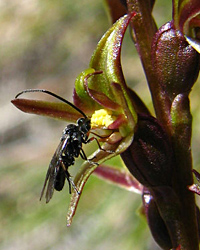 |
|
 |
|
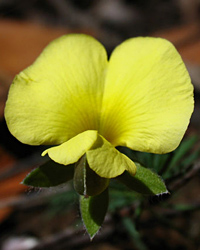 |
4. An insect visiting a
Prasophyllum flower |
|
5. Diuris orientis
Yellow form |
|
6. A member of the pea family
(Fabaceae) |
| Photos: Cathy Powers |
Seduction - Example
Fact: Seducing the male insect by using sexual deception is known only in orchids from Europe and Australia. The orchids have developed a substance known as kairomone which is a copy of the female insect's pheromone.
A very good example of this concept is the Thynninorchis huntianus (Elbow Orchid).
The Elbow Orchid takes advantage of a male Thynnine wasp by producing a scent similar to the female wasp. He is lured to the flower and sees the labellum which bears some resemblance to a female wasp (they say love is blind) - Photo 7.
The wasp may dart in and try to fly off with his 'new love'. As the wasp lifts the decoy, the labellum swings up on its hinged attachment and hurls him into the column.
The insect is more or less horizontal with the ground and his beating wings have been trapped by the column's hooked appendages which fit neatly around his body. After colliding with the column, he (not surprisingly) releases the decoy and tries to escape.
When he recovers his dignity, frees his wings and flies off, he may be carrying with him a pollen package glued to his thorax. Should he be fooled into grabbing another decoy, he will crash against that orchid's column thus transferring pollen - Photo 8.
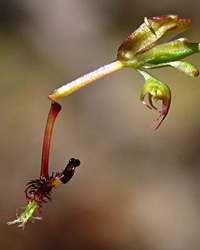 |
|
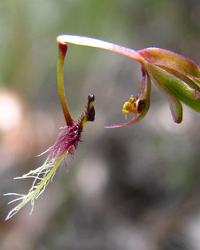 |
|
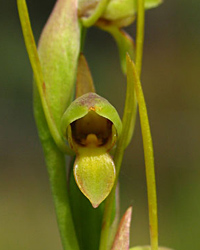 |
7. Elbow orchid flower
|
|
8. Deposited pollen
|
|
9. Horned orchid
labellum |
| Photos: Cathy Powers |
Insects Deceive Too
Another slant on the 'cooperation', with a sprinkle of 'deception', is with spiders. What an interesting turn of the table when the sneaky spider uses imitation of orchid parts to lay in wait for an unsuspecting potential pollinator.
This orchid is usually self-pollinating but some plants do have a spicy odour. This, perhaps, may attract insects that are interested in the possible nectar - Photo 9. The spider, in this example, has caused the labellum to retract and has created a similar appearance to the labellum with its own body - Photo 10.
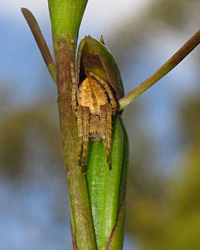 |
|
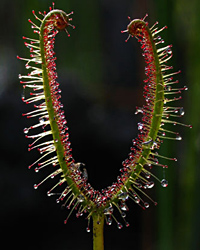 |
|
10. Spider in waiting
|
|
11. Forked sundew
Drosera binata |
|
| Photos: Cathy Powers |
|
Till Death Do We Part - Almost
Some of our best known insectivorous plants are in the Drosera group. They are often referred to as 'Sundew'. This plant uses photosynthesis for nutrition but also gets nitrogen from the insects attracted to its sticky glandular hairs. One of my favourite examples of this plant is the Drosera binata (Forked Sundew) and can readily be seen in the Grampians National Park during spring. It likes to grow along creek beds and in damp depressions - Photo 11.
From 'Growing Australian', the newsletter of the Australian Plants Society (Victoria), March 2008.
Australian Plants online - 2008
Association of Societies for Growing Australian Plants
|